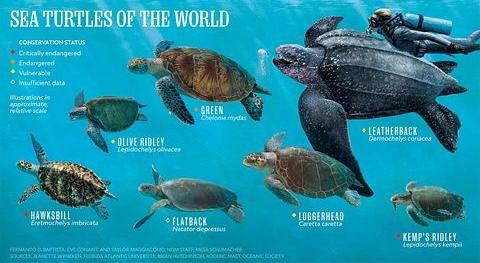
Did you know that sea turtles have been swimming in our oceans for over 100 million years, surviving mass extinctions that wiped out the dinosaurs? Today, only seven species remain, each with its own unique story and role in maintaining the health of marine ecosystems. Let’s take a look at the incredible world of these ancient mariners and uncover some of what makes each species so special.
Green Sea Turtle
Green Sea Turtles can be found worldwide and have nesting sites in over 80 countries. They are the largest of the hard-shelled turtle species, but they have pretty small heads. They have darker grey or olive colored top shells and lighter yellow or white bellies. Some other distinct traits that can help you tell if you are looking at a green sea turtle are the serrated beak (mouth) and the presence of two scales between their eyes. This species is actually the only sea turtle that is herbivorous and usually eat seagrass and algae. Don’t panic if you do happen to see one eating meat though, as they are known to prey on discarded fish and sponges from time to time. The main threats to this species include: bycatch, nesting habitat loss, vessel strikes, ocean pollution, and climate change.
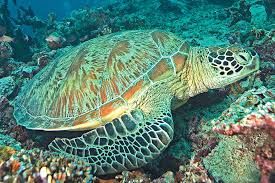
Leatherback Sea Turtle
The Leatherback Sea Turtle can be found worldwide in the Atlantic, Pacific, and Indian Oceans. In the United States, they are typically found nesting in Florida, Puerto Rico, and the Virgin Islands. It is the largest turtle in the world and the only one that does not have a hard shell. Instead, this species is covered by black, rubbery skin containing 7 ridges along its length and a white underbelly. They eat soft prey like jellyfish and salps (barrel-shaped jelly like organisms) as they don’t have the crushing plates that can be found in all other sea turtles. Identical to the green sea turtle, threats to this species include: bycatch, nesting habitat loss, vessel strikes, ocean pollution, and climate change.
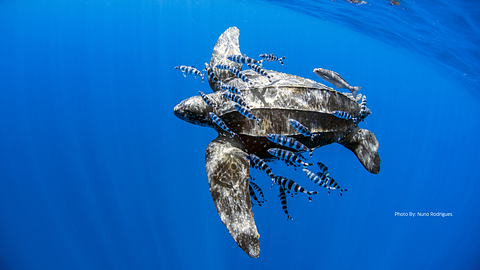
Flatback Sea Turtle
The Flatback Sea Turtle, commonly known as the Australian Flatback, can only be found in the waters surrounding Australia and Papau New Guinea. Within these locations, they prefer more inshore and coastal waters. They are covered by an olive grey top shell without ridges, and have creamy white flippers. The scales of the hatchlings are particulary unique with an olive center surrounded by a dark grey ring. Their diet consists of jellyfish, sea cucumbers, prawns, and other invertebrates. Similar to the other turtle species, main threats to their surival include: capture, nesting habitat degradation, ocean pollution, bycatch, and egg harvesting.
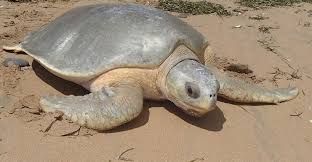
Hawksbill Sea Turtle
Hawksbill Sea Turtles can be found in nearshore waters in all of the world’s major oceans. As hatchlings, they migrate out into the open sea, but gradually move to nearshore habitats as juveniles and stay there as adults. This species has a mottled shell consisting of an abstract pattern made up of black, brown, orange, amber, red, and yellow with overlapping scales. They have tapered heads with a v-shaped lower jaw that gives them their hawk-like appearance. They are omnivorous, but their food of choice is sea sponges. However, they will also eat algae, mollusks, corals, sea sponges, and jellyfish. Threats to the species are similar to the other turtle species and include: climate change, ocean pollution, bycatch, direct harvesting by humans and predation, and vessel strikes.
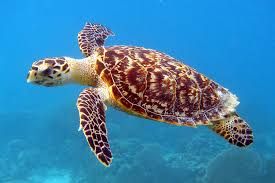
Loggerhead Sea Turtle
Loggerhead Sea Turtles can be found worldwide in subtropical and temperate regions of the Atlantic, Pacific, and Indian Oceans, as well as in the Mediterranean Sea. They have very large heads, powerful jaws, and reddish-brown flippers. Their top shell is heart shaped and is also this same reddish-brown color, while hatchlings are more dark brown in color. This species is mostly carnivorous, and only occasionally eats plants. They prefer to eat whelks (sea snails), mollusks, and horseshoe crabs. Threats to this species are vessel strikes, ocean pollution, climate change, bycatch, nesting habitat loss, and direct harvesting by humans.
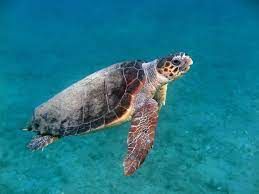
Olive Ridley Sea Turtle
The Olive Ridley Sea Turtle, named for the color of its shell, lives in tropical and subtropical waters in the Atlantic, Pacific, and Indian Oceans. They are known to forage offshore, though they typically prefer to stay in coastal bays and estuaries. As the name indicates, they have an olive colored shell that does not have ridges. Hatchlings are charcoal grey in color, though when wet, they look black and have greenish sides. This species looks very similar to the Kemp’s Ridley Sea Turtle, though a differing trait is that the Olive Ridley have 1-2 visible claws on their flippers as well as a deeper shell. Their powerful jaws allow them to eat things like crabs, shrimp, mollusks, and fish. Similar to the other species, the main threats include: harvesting of eggs and adults, bycatch, and nesting habitat loss.
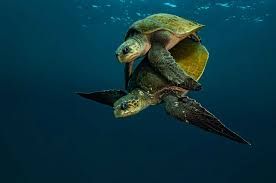
Kemp's Ridley Sea Turtle
The Kemp’s Ridley Sea Turtle is found in the Gulf of Mexico, along the eastern coast of the United States, and in coastal areas of the northwest Atlantic Ocean. Adults are pretty limited to the Gulf of Mexico, with juveniles ranging throughout the other areas. They have a triangular head with a non-ridged, dark grey/green shell with a white underbelly. The hatchlings are completely jet black. This species has powerful jaws that allow them to dine on crabs, clams, and shrimp, as well as other organisms like jellyfish and squid. The main threat to this species is egg collection and harvesting by humans, though the recent significant decline in numbers is caused by the high rate of bycatch by shrimp boats.
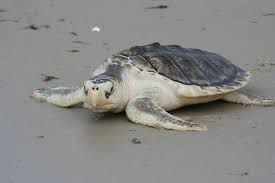
Sea turtles are not just majestic creatures of the ocean—they are vital to maintaining healthy marine ecosystems. Each of the seven species plays a unique role in balancing the delicate underwater environment, from grazing on seagrass to controlling jellyfish populations. Understanding and protecting these incredible animals is crucial for the health of our oceans and the planet. By learning about their challenges and how we can help, we take a step closer to ensuring their survival for generations to come. Together, we can make a difference for sea turtles and the world they call home. Make sure to check back regularly for more sea turtle updates from TurtleUp!
